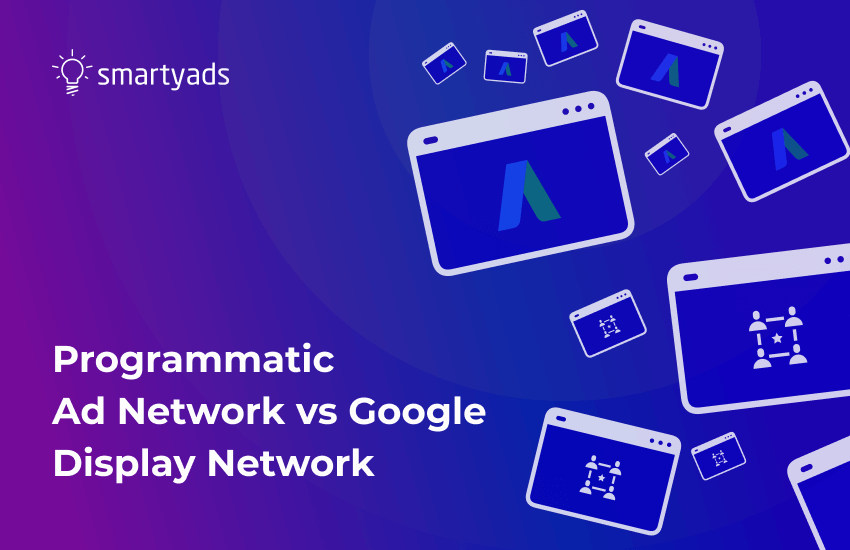Programmatic advertising has long been a normal part of our everyday life. Over the past few years, programmatic advertising has been growing particularly rapidly and has confidently taken the lead in most advertising rankings and statistics. Recent forecasts from Statista show that programmatic advertising will reach $418 billion in 2021. It is expected to grow to $725 billion by 2026. These are extremely impressive numbers, considering we are talking about a span of only 5 years.
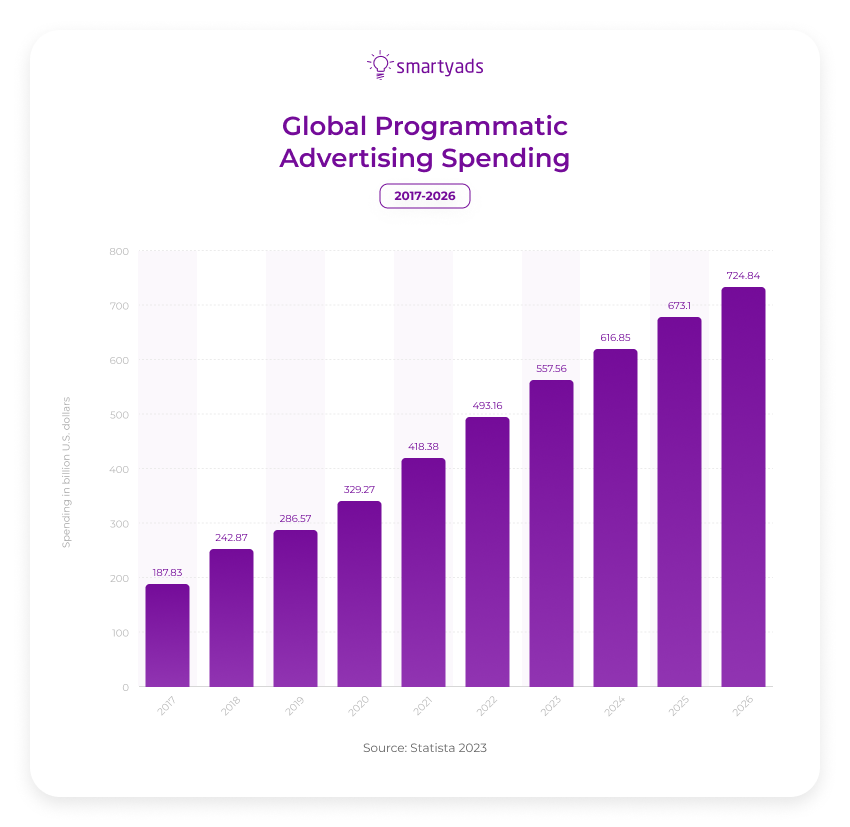
As new concepts and technologies are being introduced, it is sometimes not so easy to keep up with everything, especially when the methods are pretty much similar to each other.
Programmatic network and Google Display Network are good examples of such, so to avoid confusion, let us now compare the two and check when one performs better than the other.

Importance of programmatic ads and Google ads
The importance of these two methods is in automation since both ways of ad placement enable media buyers to buy the right traffic automatically via self-served platforms (which was unavailable at the age of manual ad placement.
How are the GDN and programmatic advertising similar?
Both are platforms designed for self-serve advertising enabled by automated algorithms and equipped with great targeting. However, they are a little bit different. Let's dig a bit deeper.
What is the Google Display Network?
Display advertising was introduced in the 90s; back then, it mostly included various kinds of banners shown to users through display ad networks. Many different display networks, such as Conversant, Yahoo, Bing, and Google, account for more than 2 million websites.
How does the Google Display Network work?
Google Display Network (GDN) operates as an interconnected system of publishers and supply partners within the Google Ads ecosystem.
Serving as a mediator between advertisers and a network of affiliated publishers, GDN provides advertisers with a user-friendly interface for essential audience targeting, ad scheduling, and other options to effectively reach their audience within Google's vast network.
Moreover, it seamlessly integrates with other Google platforms, such as Google Analytics, and works in tandem with Google Ad Manager to offer advanced ad management and optimization capabilities for publishers and advertisers alike.
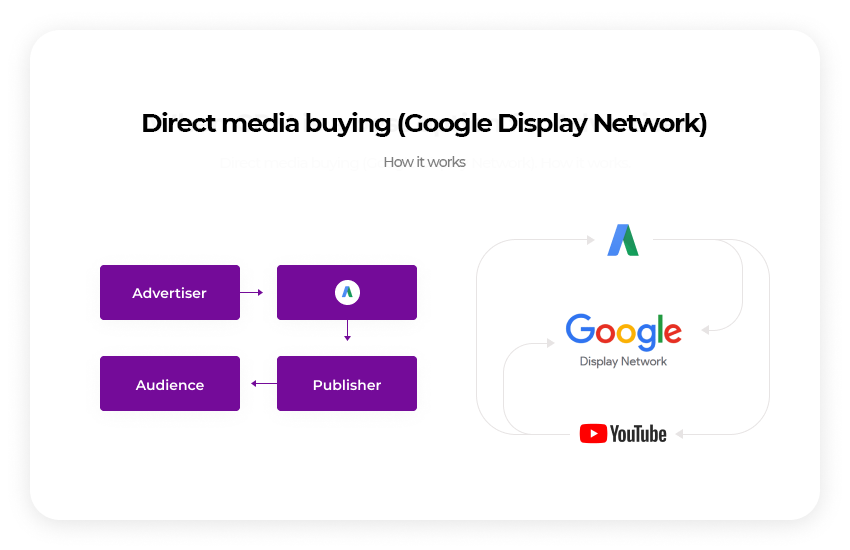
What is a programmatic ad network?
Programmatic advertising network gathers advertisers and publishers from all around the world. It allows advertisers to buy ad placements and ad inventory under the best conditions, usually matched by RTB. There are several things you need to know about programmatic ad buying.
The process of programmatic advertising also takes place on special platforms — ad exchanges. They work similarly, but ad exchanges are slightly different from ad networks. Programmatic networks and ad exchanges connect advertisers (DSPs) and publishers (SSPs) together and conduct real-time auctions. Everything works according to the following algorithm:
Advertisers sign up to the demand-side platform (DSP) and place their ad campaign, specifying properties of the ad, such as size, format, etc.
Next, they choose their target audience, as well as the conditions under which they want this audience to receive an ad. On the other side, a publisher gets to the SSP, a supply-side platform, and provides their available ad placement with an indication of what ad formats and sizes they support.
Once a user visits their website (which contains an ad placement), the bidding process starts (real-time bidding) among advertisers whose ad conditions match the provided ad inventory.
The one who offers the highest bid wins. A user sees the winner's ad and all of this within less than a second.
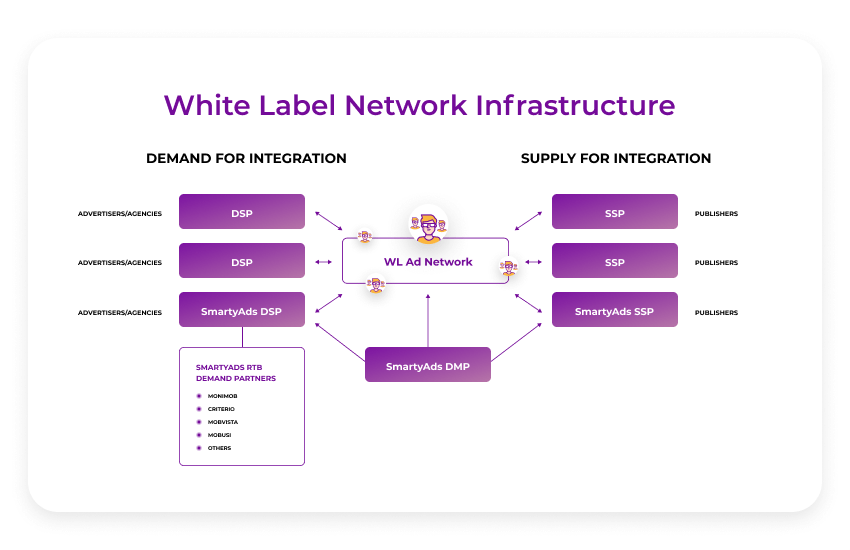
Are the GDN and programmatic advertising similar?
Google Display Network (GDN) and programmatic advertising share common ground in the digital advertising landscape, yet they diverge in several key aspects.
GDN primarily centers on ad placements within Google's ecosystem, comprising platforms like YouTube, Gmail, and partner websites. It often involves direct negotiations between advertisers and Google for specific inventory.
In contrast, programmatic advertising represents a broader and more automated approach. It extends beyond Google's properties, encompassing a vast network of publishers and digital platforms. Here, the buying and placement of ads operate in a real-time bidding environment driven by data insights and algorithms.
While GDN offers advertisers a controlled and predictable environment, programmatic advertising delivers greater flexibility and reach. Advertisers can access a wealth of data and insights, allowing for more precise targeting and optimization across a wider digital landscape.
This results in an advertising ecosystem that combines the benefits of automation, data-driven decision-making, and a vast publisher network to cater to diverse advertising needs.

What is better for a wider reach?
It is much easier to understand the difference between programmatic ads and Google Display Network when we compare them within certain functions, so let's start with the audience reach.
The audience of GDN includes all of their partner websites, which have signed up to their network. Although this number is really huge, it is still limited, in contrast to what programmatic advertising has to offer.
The ad exchange gives advertisers access to many SSPs, including Google Network, so ads can be served to more people than any display network can cover. Therefore, if you want to reach a broader audience, you should definitely opt for the programmatic network rather than the Google Display Network.
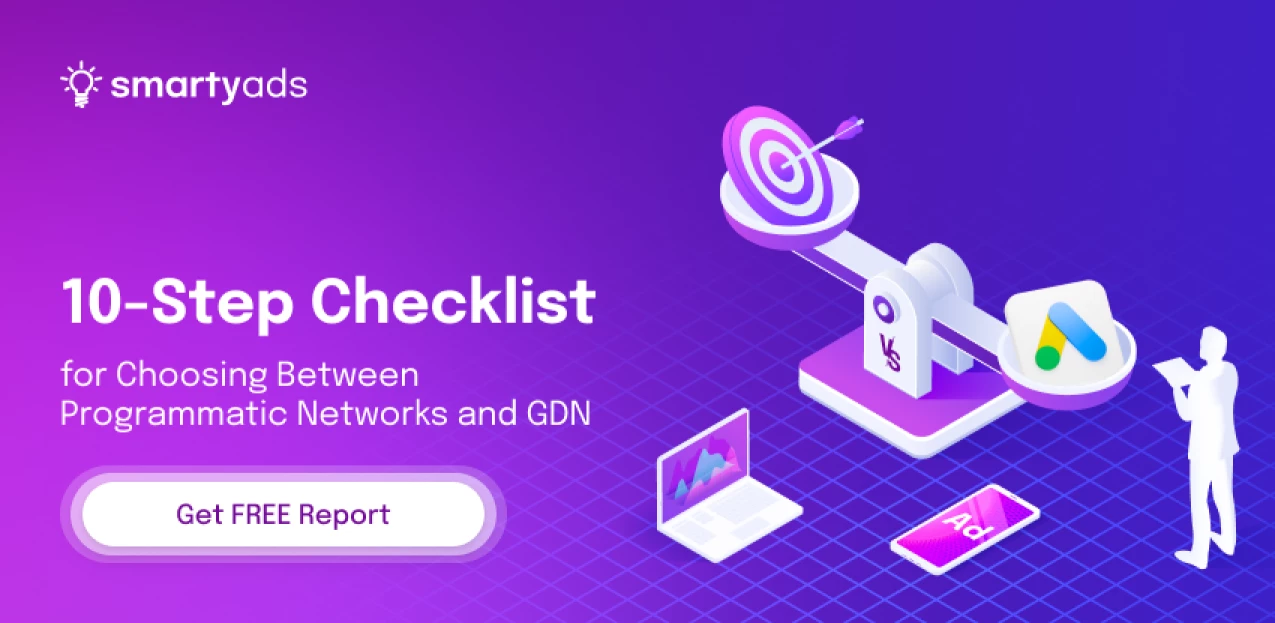
Who offers better targeting?
When it comes to advanced targeting capabilities, there are many different options to compare Google Display Network and programmatic advertising platforms. You can target users by keywords, related topics, users' interests, and demography. However, the data used by these platforms can vary significantly.
The Google Display Network has Google search history at its disposal, while programmatic advertising allows you to make use of third-party data. This provides huge opportunities to target users by lots of very specific characteristics and to segment an audience more effectively. This gives you the opportunity to create behavioral advertising.
Given that the volume of in-depth data available through third parties is much bigger, programmatic advertising clearly wins this round, as it does not limit advertisers to one source of information. Thus, it gives more options in both targeting and audience segmentation.
How do I select which ads to sell via direct or programmatic?
Programmatic direct is an automated method of buying and selling ad inventory that combines the efficiency and data-driven targeting of programmatic advertising with the predictability and assurance of direct deals.
It involves negotiating terms between advertisers and publishers, then executing ad transactions programmatically, streamlining the process, and offering transparency, precision, and brand safety.
Programmatic direct combines the benefits of programmatic advertising with the control and certainty of traditional direct deals, making it an attractive option for advertisers and publishers looking to streamline their advertising transactions while ensuring the desired outcomes.
Where can I get more variety of ad formats?
Most ad formats are covered by both Google Display Network and programmatic network. Google Display Network supports banner ads, video, and rich-media ads.
One downside, however, is the fact that lots of publishers who are partners of Google do not support rich media for their placements. This can be a problem for advertisers who would like to interact with users and get more engagement using this ad format.
Programmatic advertising platforms also allow advertisers to work with native advertising, which is especially effective against banner blindness.
Apart from this, native ads are well-known for good user engagement and raising brand awareness. So, if you are interested in best-performing mobile ad formats, such as rich media and native advertising, programmatic advertising platforms will probably suit your campaign better.
What should I use for video ads?
Both programmatic advertising and Google Display Network allow the use of video advertising. The main difference lies in the target audience provided by the two. While Google Display Network includes a huge amount of websites in its partnership, not so many of them support video ad options. Therefore, video ads with Google Display Network mostly use YouTube as the main platform, which might not be enough in some cases.
If you want to work with specific websites and not just limit yourself to YouTube videos, programmatic advertising will probably work better for you.
This might be especially useful for targeting a niche audience focused on a specific topic or product. The choice between programmatic advertising vs Google Display Network is easy to make once you know exactly who you want to reach.
Who offers more pricing models?
Choosing a pricing model is a very important step, as ad revenue can directly depend on it. And ad revenue is brand revenue, which is what all marketers strive for.
In contrast to other features, the online ad pricing models used by programmatic ad networks and GDN differ significantly.
Google Display Network offers the following options:
CPC, where cost is counted for each click; CPM, which is calculated for every thousand impressions; and CPA, which is decided based on a specific action, such as sharing an email or playing a mini-game.
Programmatic ads offer:
Programmatic ads, on the other hand, are usually calculated using CPM or cost-per-mille formula. According to this model, to get the price, one should count total impressions, divide it by 1000, and then divide ad spend by this number. This might be somewhat limiting for those who would like to try different pricing models, but for most marketing purposes, CPM is the best and the most affordable option.
What about the cost?
In terms of cost efficiency, the choice of platform should depend on the amount of money that you expect to spend. Google Display Network does not require minimum payment, which works well for beginners.
Networks, on the other hand, are generally more oriented on a monthly payment for campaign maintenance, usually something around $5,000 to $10,000. Hence, if you want just to start from small prices in order to test how the whole process works, then GDN would suit you well, at least until you decide to do bigger ad campaigns and spend more money on them.
At the same time, programmatic advertising has one significant advantage: the automation of bidding and the ability to buy ads instantly.
The process becomes much more productive as most of the manual work is done by machines in a brief moment. Programmatic ads remove the possibility of human error in the process and enable best practices of bidding on a huge scale for both sides of the auction in mere seconds.
Conclusions
To sum up, we can see that the Google Display Network works well as a place to try online advertising, as it provides opportunities to try different pricing models and doesn't require huge ad spending.
For a larger-scale ad campaign, however, a programmatic ad network seems to work better because it includes a great number of additional options for a successful campaign operation.
Using ad network, advertisers receive an opportunity to improve their ad strategy, reach a wider audience, segment it, and target users effectively.
Moreover, it provides a huge variety of ad formats, including rich media and native ads. Finally, platforms for video ads are also usually better represented on programmatic advertising platforms. Isn't it time to try?
With our new DSP, you get all these benefits for your ad campaigns. Don't limit your opportunities — sign up at SmartyAds DSP!
FAQ
The main difference between Google Display Network (GDN) and programmatic advertising lies in their scope and operation. GDN focuses on ad placements within Google-owned properties, often involving direct negotiations.
Programmatic advertising, on the other hand, covers a broader network of publishers, operates in an automated and data-driven manner, and typically utilizes real-time bidding, providing more extensive reach and targeting options.
Programmatic advertising typically offers more available ad space compared to the GDN. GDN primarily provides ad placements within Google-owned properties, while programmatic advertising extends across a wider network of publishers, websites, and apps.
This broader ecosystem allows advertisers to access a larger inventory of ad space and reach a more diverse audience.
Programmatic ad buying is an automated method of purchasing and placing digital advertisements. It uses algorithms, data analysis, and real-time bidding to determine ad placements.
Advertisers set targeting criteria, and the system automates the process, ensuring ads are displayed to the right audience at the right time, optimizing efficiency and effectiveness in online advertising campaigns.

